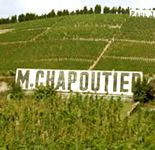 | The huge shift in quality that came about is largely attributed to Michel. As is the case with many top winemakers Michel Chapoutier believes that great wine is made in the vineyard, not in the cellar, and so it is here that some of the most dramatic changes were made. The press wine - frequently a source of harsh tannins - is not used. In order to make the whites more approachable in their youth aliquots of each wine undergo separate vinifications with one third in barrel, enamel and inox vats. Most importantly, the Chapoutier put an end to the excessive fining and filtration previously employed, and the top cuvées are now bottled without any fining or filtration at all. And for many appellations Chapoutier introduced super-cuvées, from selected parcels of old vines, some of which are of extremely high quality. Overall, the Chapoutier style is intended to be approachable young, but with the structure to age. One aspect of the Chapoutier style that has come in for criticism is their use of oak. Michel in fact reduced the period of ageing in oak from two years to eighteen months, but of the barrels used up to one third are new, which can make for a very oaky impact on the wine. |
| Chapoutier owns plots that occupy a significant proportion of the hill of Hermitage, in a number of vineyards, including Les Bessards, Greffieux, Chapelle, Méal, Muret and Chante-Alouette. From these plots come a number of red and white Hermitage cuvées. The whites can be fabulous and include Chante-Alouette, l'Ermite, Le Méal and De l'Oree. The red cuvées include Pavillon, La Sizeranne, l'Ermite, Le Méal and a young vines cuvée Mûre de Larnage. There is also a Vin de Paille - a sweet wine made from dried grapes. In addition Chapoutier owns vines in Cote Rotie - source of La Mordorée and Les Bécasses. |  |